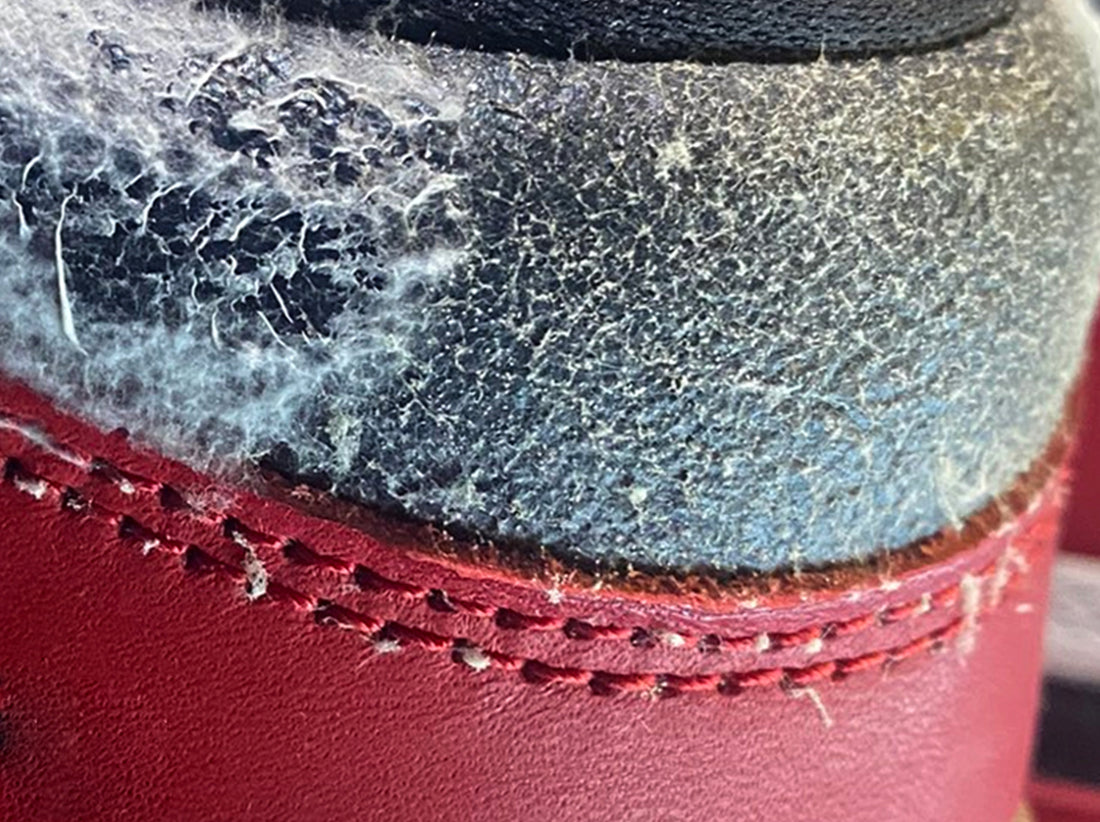The environments that we live in effect all factors in our day-to-day life. Humidity is one of those environmental factors that have such a visible effect that it quickly impacts what we wear, how much time we spend in-doors and out, and even how our hair looks! It is also one of those elements that is harmful if not dealt with properly, not only to our health, but also to our belongings.
Shoes are unfortunately one of things that are drastically effected if not cared for properly in high-humidity environments. It is a nightmare that will make your beautiful leather shoes prone to developing mold. This can grow all over your shoe uppers, soles and even in the insides of your shoes with visible white, yellow or green mold. Mold on shoes, mold in shoes, moldy shoes it's just a nightmare!

Luckily, there are a few pre-storage and storage steps you can take to avoid ruin to your shoes and avoid gettin mold on shoes.
So let’s get to it!
-
Pre-storage: Cleaning
Before even worrying about where or how to store your shoes, make sure that they are never stored damp or soiled in the first place as mildew feeds on this in any kind of environment and can lead to mold on shoes. It is crucial to clean your shoes before storing them, especially if they will not be worn again soon. Following regular and simple cleaning techniques works well, and you can see these in the How to Keep Your Shoes Shinning blog.
-
Pre-storage: Using a Shoe Tree
Natural moisture in your shoes is also something that must be taken into consideration and cared for to avoid additional or expedited moisture-related mold on shoes ruin in a high-humid environment (or any environment for that matter). This moisture might have been created by sweaty feet or if your shoes got wet while walking outdoors. In any case, this excess moisture will not only have your shoes smelling bad, but will also eventually lead to dry rot - and moldy shoes!
The best way to deal with this would be with the use a shoe tree. Cedar shoe trees would be the best option for this as they not only maintain the shape of shoes, but also absorb any excess moisture from the inside of the shoes to avoid mold in shoes.
Plastic shoe trees are also a good option to use, but for high-humid environments, I would recommend to additionally place a few desiccant pouches inside your shoes. These will absorb the excess moisture that a wooden shoe tree would have done (I will discuss these pouches further below) and help to prevent mold in shoes.
To understand more about shoe trees and find the most suitable option for you, you can always refer to our shoe tree guides Why You Need Shoe Trees and Types of Shoe Trees.
If none of the shoe-tree options are available or work for you, you can simply use newspaper or acid-free paper that also act as moisture-absorbents!
-
Desiccant pouches
Desiccant pouches, or silica gel packs, are those little white sachets that you find in a lot of packaged products. You would typically find them in anything from shoe boxes and bags to medicine jars. I used to throw them away until I found out they are of great use and make sure to use them when storing my shoes!
They are inexpensive and effective, especially when using ones found in other products you’ve bought! They lower relative humidity by collecting moisture in the air, and aid in preventing mold formation.
-
Pre-storage: How to store
Trapped humidity is a potential culprit of moldy shoes, and although using items such as plastic bags, sealed containers or plastic boxes may seem convenient, these containers can trap high levels of humidity. Using such items will lead to faster and worse mold growth because of the lack of airflow crucial for your leather shoes and cause mold in shoes.
It is best to store your shoes freely using a shoe tree (as stated above), and in a fabric dust bag if desired to also keep them free of dust.
-
Storage: The Space
Storage space is key. We need to think of the size of the space in relation to the number of items, air-flow and, most importantly, the atmosphere in there. If the atmosphere inside your closet is already damp or dirty it will help foster mold growth on the items in your closet.
Simply put, if mold already exists in your closet, it will just spread out onto anything else in there, so it is important to make sure that the closet or drawer you will be using for storage is in itself free of any mold to avoid mold on shoes as well.
Air flow helps to prevent mold, so it is also important to avoid overcrowding your storage space by making sure there is enough space between the items in your closet. Shoe racks made of rods (and not full planks) are a great addition to your closet as they provide good ventilation between each pair of shoes.
It is also a good idea to take your shoes out and place them in some fresh air on a dry and sunny day.
-
Storage: The Temperature
The most ideal temperature would be to keep your shoes (or any leather good for that matter) at a temperature that falls between 10 and 21°C with a humidity that would fall between 30 and 60%. If we are getting fancy over here, then using a hygrometer would be the most ideal way to measure these numbers.
-
Storage: Dehumidifiers
Using a dehumidifier is the best way to keep the air humidity under control and keep away mold on shoes. You don’t have to splurge on an expensive electric or battery powered one. A simple moisture absorbent dehumidifier box, typically found at the supermarket and available from a multitude of brands, works well.

These use desiccant materials that will effectively absorb water and are good enough for your closet since it is a small and compact space. Just make sure to follow the package instructions, empty the water when it fills and replace the tab or gel once it has completely dissolved.
Signing-off: Rana Cheikha for The Shoe Advisor
// Get in touch here or by email at rana@ranacheikha.com for more insight, queries and information //

